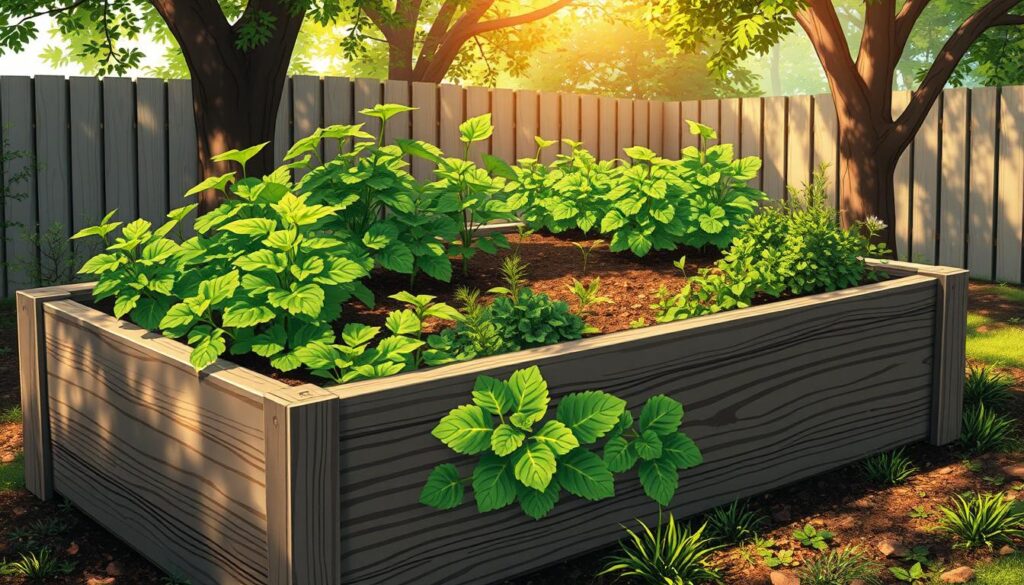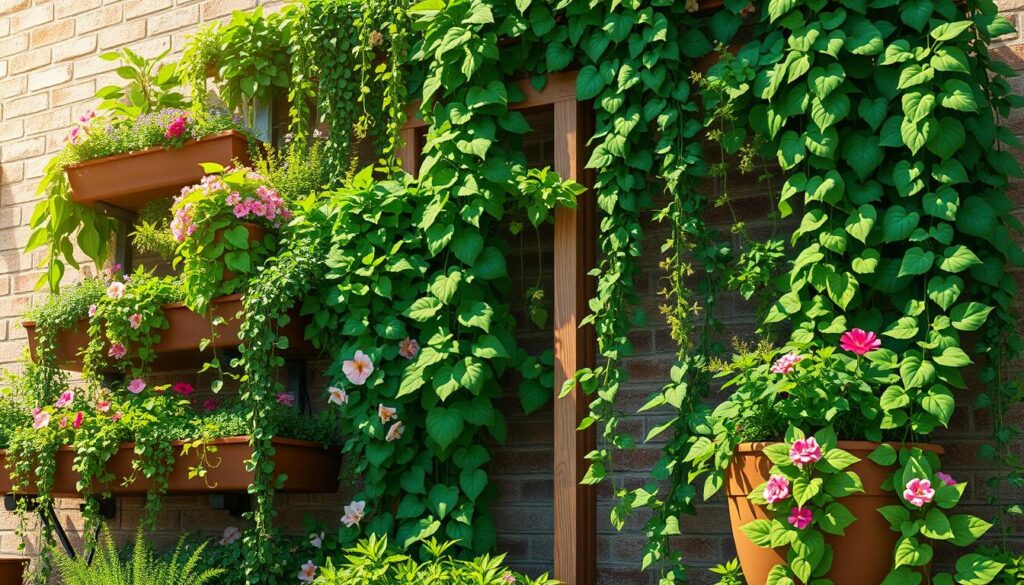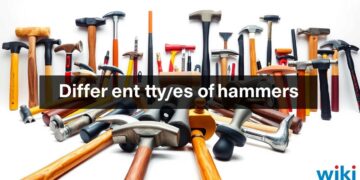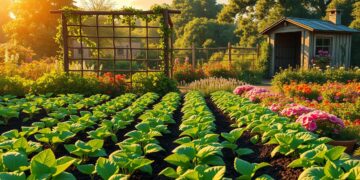Gardening fans often want to grow more. Did you know the right planting methods can boost your garden’s yield by up to 50%?
This big increase comes from using the right gardening techniques. We’ll look at four key methods to boost your garden’s yield. These strategies can make your gardening more efficient and your harvest bigger. For more info, check out Fox Run Environmental Education Center for gardening tips.
Key Takeaways
- Understand the different planting methods to maximize garden yield.
- Learn how to improve gardening efficiency with the right techniques.
- Discover the benefits of adopting alternative gardening strategies.
- Explore resources for further learning on gardening methods.
- Apply the most effective planting methods for a bountiful harvest.
Understanding the Basics of Planting Methods
Starting your garden right is all about the basics of planting. The way you plant can really change how well your garden does. We’ll look at why picking the right method is key and how to choose the best one for you.
Why Planting Methods Matter
Planting methods can change a lot, like soil health and pest control. Different planting techniques help use space better, stop soil erosion, and keep air moving. For example, intensive planting makes every inch of soil count by using smart spacing and planting together.
Choosing the right method also means using fewer chemicals. This is good for the planet and makes your garden healthier.
Choosing the Right Method for Your Garden
With so many planting options, picking the right one can be hard. But think about your garden’s size, the plants you want, and what you hope to achieve. Also, think about what you have, like time, money, and tools.
Knowing the basics of these methods is crucial for a great garden. Whether you’re new or experienced, the right method can really help your garden thrive.
Traditional Row Planting: An Overview
Gardening with traditional row planting is easy and effective. It means planting crops in rows for easy access and care. This method makes gardening more organized and productive.
Benefits of Row Planting
Row planting makes it easy to get to your crops. You can walk between rows to check plants, do maintenance, and pick crops. It also helps avoid soil damage from too much walking or machinery.
Key benefits of traditional row planting include:
- Ease of access for maintenance and harvesting
- Reduced soil compaction
- Improved crop organization
- Simplified irrigation management
Gardening expert, Michael Dirr, says, “Proper spacing and arrangement of plants are crucial for a healthy and productive garden.”
“The arrangement of plants in a garden can significantly impact their growth and overall health. Traditional row planting offers a straightforward approach to achieving this.”
Ideal Crops for Row Planting
Row planting works well for many crops, but some are better suited. Crops like corn, beans, and squash need a lot of space. Root vegetables like carrots and beets also do well in rows.
| Crop | Spacing | Yield Potential |
|---|---|---|
| Corn | 8-12 inches | High |
| Carrots | 2-3 inches | Medium |
| Beans | 3-6 inches | High |
Knowing the benefits and best uses of row planting helps you garden better. It can make your garden more productive.
Square Foot Gardening: Maximizing Space Efficiency
One of the best modern planting ideas is square foot gardening. It divides your garden into small, easy-to-manage squares. This is great for those with little space, as it lets you grow many different crops in a small area. It helps you get a lot of food from even the smallest gardens.
Key Principles of Square Foot Gardening
The secret to square foot gardening is its simplicity and planning. Dividing the garden into square sections is the first step. This is done using a grid to make many small beds. It makes the garden easy to organize and take care of, as each section is its own area.
To do square foot gardening well, follow these key principles:
- Crop Selection: Pick crops that grow well together and don’t spread out too much.
- Soil Preparation: Make sure the soil is full of nutrients and drains well.
- Pathways: Keep enough space between beds for easy walking.
As Melianie Choukas-Bradley said,
“Gardening is a love song, a duet between a human being and Mother Nature.”
This quote shows what square foot gardening is all about. It’s about working with nature to grow a lot of food.
Recommended Crops for Square Foot Gardening
Not every crop is good for square foot gardening. The best ones are small, grow a lot, and do well near other plants. Some top picks include:
- Leafy greens like lettuce and spinach
- Herbs such as basil and cilantro
- Cherry tomatoes and peppers
- Radishes and other root vegetables
By picking the right crops and following square foot gardening’s rules, you can make a garden that’s both productive and space-saving.
Raised Bed Planting: Enhancing Soil and Drainage
Gardeners looking to improve their planting can try raised bed gardening. This method creates beds above ground. It helps with soil drainage and warmth, making plants grow better.
Advantages of Raised Beds
Raised beds have many benefits. They improve soil drainage and make the soil warmer. This is great for plants. Better drainage means less waterlogged soil, which is bad for plants.
They also let you plant earlier because the soil warms up faster. Raised beds help you make the soil better by adding organic matter. This way, you don’t have to change the whole yard.
Gardening expert says, “Raised beds let you control the soil. You can make it perfect for your plants.”
Best Practices for Constructing Raised Beds
When making raised beds, follow some key steps. This will help them work well.
- Choose a spot that gets enough sunlight for your plants.
- Use strong, safe materials like untreated wood or composites.
- Make the beds not too wide. This makes it easy to reach the middle.

By following these tips, gardeners can make raised beds. These beds improve soil and make gardening more fun and productive.
Companion Planting: Enhancing Growth Naturally
Companion planting is a simple way to make your garden better. It means growing different plants together to help each other grow. By picking the right plants, you can make your garden more balanced and diverse.
Benefits of Companion Planting
Companion planting has many benefits. It can control pests, help plants grow better, and even make food taste better. For example, marigolds can keep pests away from tomatoes.
It’s important to know how plants work together. Some plants give shade, act as trellises, or make the soil better for others. Beans use corn stalks as trellises, and squash keeps the soil cool and moist.
Examples of Beneficial Plant Combinations
Here are some good plant pairs for your garden:
| Main Crop | Companion Plant | Benefit |
|---|---|---|
| Tomatoes | Basil | Improved flavor and pest control |
| Cucumbers | Dill | Repels aphids and other pests |
| Cabbage | Sage | Repels cabbage moths and other pests |
| Carrots | Onions | Repels pests that target carrots |
For more info on companion planting, check out The Old Farmer’s Almanac guide. It has a detailed list of good plant pairs and tips for your garden.
Vertical Gardening: Utilizing Vertical Space
Vertical gardening is a great way to make the most of your garden. It uses trellises and other supports to grow plants up. This is perfect for small spaces because it lets you grow more plants in less room.
Techniques for Vertical Gardening
There are many ways to do vertical gardening well.
Trellising: Trellises help climbing plants like peas and beans grow up.
Wall-mounted Planters: Planters on walls are great for herbs and succulents.
Vertical Gardening Systems: These systems are more complex but very effective.

Suitable Plants for Vertical Growth
Not every plant does well in vertical gardens. Here are some that do great:
Climbing Plants: Peas, beans, and cucumbers love to climb.
Flowering Plants: Clematis and morning glories add color.
Herbs: Mint and rosemary grow well up high.
| Technique | Description | Suitable Plants |
|---|---|---|
| Trellising | Using trellises to support climbing plants | Peas, beans, cucumbers |
| Wall-mounted Planters | Attaching planters to walls for growing plants | Herbs, succulents, strawberries |
| Vertical Gardening Systems | Specialized systems for vertical gardening | Variety of plants, including leafy greens and tomatoes |
Hydroponics: Soil-Free Solutions for Planting
Hydroponics is changing how we grow plants. It uses a soil-free method that boosts yield and cuts waste. Plants grow in a nutrient-rich solution, not soil. This setup controls growth for better results.
How it Works
Plants in hydroponics grow in a special setup. Their roots are in a nutrient-rich solution, not soil. This lets growers control what nutrients plants get for best growth. Nutrient Film Technique (NFT) and Ebb and Flow (Flood and Drain) are top hydroponic systems.
The solution given to plants is made to give them all needed nutrients. Without soil, hydroponics cuts down on diseases and pests. It’s a cleaner, more efficient way to grow food.
Advantages of Hydroponics
Hydroponics is very water-efficient. It uses much less water than traditional farming. This is great for places where water is hard to find.
It also boosts crop yield. Plants grow faster and produce more. Plus, hydroponics lets us grow crops all year, no matter the weather outside.
Indoor Planting: Extending Your Growing Season
Indoor planting lets you grow plants all year, no matter the weather outside. It creates a space where plants can thrive. This way, you can grow plants longer than usual.
Best Indoor Planting Strategies
To grow plants indoors well, you need the right plan. First, think about the light your plants need. Most plants need lots of light to grow. So, put them near a sunny window or use grow lights.
Keeping the right temperature and humidity is also key. Each plant has its own needs. So, learn what your plants need to stay healthy.
Choose the right containers and soil too. Containers should let water drain well to avoid root rot. Use a good potting mix for indoor plants. Also, indoor plants need less fertilizer than outdoor ones. So, adjust how often you fertilize them.
Ideal Indoor Plants for Beginners
For beginners, start with easy plants. Good choices are Snake Plants, ZZ Plants, and Pothos. These plants are easy to care for and clean the air.
Spider Plants and Dracaena are also great for beginners. They can handle forgetting to water sometimes. They also grow well in different light conditions. Starting with these plants helps you learn and grow your indoor gardening skills.
Comparing Methods: Which is Right for You?
There are many ways to plant a garden. It’s important to look at the good and bad of each to choose the best for yours. Think about a few key things that will help you decide.
Factors to Consider in Your Decision
When picking a planting method, think about a few things. How much space do you have for your garden? What plants do you want to grow? And how much money are you willing to spend at the start and later on.
If you don’t have much space, Square Foot Gardening or Vertical Gardening might be good choices.
Also, think about how much gardening experience you have. If you’re new, Traditional Row Planting or Raised Bed Planting might be easier. They need less special equipment.
Cost-Effectiveness of Each Method
How much each planting method costs is different. For example, Hydroponics can be pricey at first because of the special gear needed. But it can save water and give high yields later.
On the other hand, Companion Planting is often very cheap. It just means moving your plants around or adding a few new ones without spending much.
As
“The right planting method can turn your garden into a thriving oasis, providing you with fresh produce and a sense of accomplishment.”
By thinking about these points and knowing how much each method costs, you can pick the best one for you. This will make your gardening journey better.
Conclusion: Choosing the Best Planting Method for Your Garden
We’ve looked at many planting methods, like row planting and hydroponics. Each has its own good points and challenges. Think about your garden’s space, soil, and the plants you want to grow when choosing.
Trying out different planting techniques can help you find what’s best for you. For example, in-ground gardens have lots of space and keep moisture. Raised beds drain well and warm up faster. Container gardens are great for small spaces and are perfect for growing herbs and veggies.
Putting Your Knowledge into Practice
Knowing about different planting methods helps you make a garden that thrives. Don’t hesitate to try new things and change your plan if needed. With practice and patience, you’ll get the most from your garden and enjoy a big harvest.



















